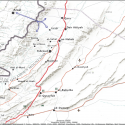 |
 |
The Fall of Yabroud and The Campaign for the Lebanese Border
Mar 26, 2014 - Anonymous


As the most significant remaining rebel stronghold in the Qalamoun region, the fall of Yabroud is an important strategic victory for the regime and demonstrates improved operational planning by pro-Assad forces.
Yabroud Offensive
Yabroud is located in the rugged terrain of the Qalamoun Mountains and sits astride the M5 highway which connects Damascus to Homs and the Mediterranean coast. Rebel control of Yabroud had disrupted the regime’s freedom of movement along the M5 highway and created a staging ground for rebel attacks against Hezbollah targets in Lebanon. In mid-November 2013, the regime intensified operations to clear the area in order to regain control of the section of the M5 highway running from Qara to Yabroud. Regime forces supported by Hezbollah and National Defense Force (NDF) fighters pushed along the main highway moving from north to south, and seized Qara on November 15th, Deir Attiyah in late November, and an-Nabek in mid-December. Pro-regime forces then pressed towards Yabroud where their advance slowed until launching a renewed offensive against the town in February 2014.
The Yabroud offensive began with clearing operations and air strikes on the town’s surrounding areas in order to isolate rebels in Yabroud from their supply lines, a tactic that was used in the battles for al-Qusayr and as-Safira in 2013. Throughout the month of February, regime forces advanced from the north, concentrating air strikes and bombardments on the Rima Farms which lie in the northern outskirts of Yabroud. Air strikes and bombardments also targeted the road northwest of Yabroud to Falita, the town of al-Sahel to the north, and the surrounding mountains of Mar Maroun. Hezbollah played a leading role as it has throughout the regime’s Qalamoun operations, particular in reconnaissance missions which allowed regime forces to identify and target rebel ground lines of communication between Yabroud and Arsal in Lebanon.
In early March 2014, regime forces continued shaping operations around Yabroud, seizing the village of al-Sahel, north of Yabroud, the Kuwait and Qatari hills which overlook Yabroud, and the Rima farms on March 11th. Opposition forces claimed to have pushed back the following day but pro-regime forces launched a final attack against the town on March 14th. The attack began with Hezbollah fighters conducting a diversionary operation from the west and north before pro-regime forces launched the main attack from the east. A passage was left open for rebel withdrawal either to the south of Yabroud leading to south-western towns and village of Qalamoun or northwest into Lebanon. After the fall of Yabroud rebels retreated to other towns in the southern part of Qalamoun, namely Falita, Rankous, Hawsh al-Araband Assal al-Ward as well as across the border to Arsal in Lebanon.